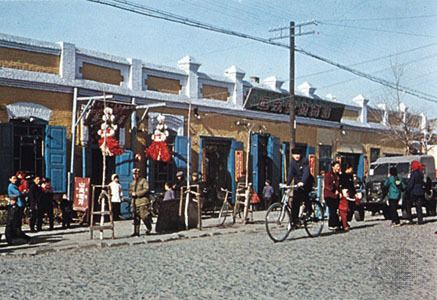Time zone China Standard (UTC+8) Area 1,440 km² Area code 0470 | Elevation 614 m (2,014 ft) Postal code 021000 Local time Wednesday 3:17 AM Number of airports 1 | |
 | ||
Weather -14°C, Wind E at 11 km/h, 79% Humidity Points of interest prairie, Genghis Khan Square, Da'er Jilin Si | ||
Hailar District (Mongolian: ᠬᠠᠶᠢᠯᠠᠷ ᠲᠣᠭᠣᠷᠢᠭ Qayilar toɣoriɣ Хайлаар тойрог, Cyrillic: Хайлаар дүүрэг, Khailaar düüreg; simplified Chinese: 海拉尔区; traditional Chinese: 海拉爾區; pinyin: Hǎilā'ěr Qū) is an urban district that serves as the seat of the prefecture-level city Hulunbuir in northeastern Inner Mongolia, China. Hulunbuir, due to its massive size, is a city in administrative terms only, being mainly grassland and rural. Hailar, therefore, is a de facto city. Hailar can also refer to the urban area around the Hailar district, with Hulunbuir being the wider geographical region that contains the urban area.
Contents
- Map of Hailar Hulun Buir Inner Mongolia China
- History
- Transportation
- Climate
- Culture
- Sister city
- References
Map of Hailar, Hulun Buir, Inner Mongolia, China
Long known as the "Pearl of the Grasslands", Hailar acts as a gateway between China and Russia. The district has an estimated population of 256,000, and serves as a regional centre for commerce, trade, and transportation.
History
Hailar was founded as a Chinese fort in 1734, and during the administration of the Republic of China it was the capital city of Xing'an Province. It is now a centre of agricultural production on the Chinese Eastern RR. Once known as Hulun, Hailar today is a relatively small but thriving modern industrial city of around 300,000, its population having soared from an estimated 20,000 in the mid-20th century.
It was occupied and fortified by the Japanese during their expansion into Manchuria, Inner Mongolia, and China proper during the 1930s until the end of the Second World War in August 1945, and perhaps the oldest building in Hailar that stands today was left by the occupying forces. When the Soviet Union declared war on Japan, Hailar was the scene of a bitter struggle in the wider campaign to push Japanese forces out of Manchuria and northeast China and Korea (see Soviet invasion of Manchuria (1945)).
Transportation
Hailar Dongshan Airport serves the city, with flights to Beijing and Shenyang amongst others. Hailar's railway station is the penultimate major station before Manzhouli, the port city that stands close to the Russian border. It is on the famous Manchuria branch of the Trans-Siberian express route and China National Highway 301. Trains to Harbin take about 12 hours, and 27 to Beijing. Hailar has a frequent series of buses that cover the town.
Climate
Hailar has a humid continental climate (Köppen Dwb) bordering on a subarctic climate (Köppen Dwc). Winters are long, very dry and severe, due to the semi−permanent Siberian High, while summers are short, though very warm, and rather wet, due to the East Asian monsoon. The monthly 24-hour average temperature ranges from −25.1 °C (−13.2 °F) in January to 20.0 °C (68 °F) in July, while the annual mean is −0.96 °C (30.3 °F). With monthly percent possible sunshine ranging from 55% in December to 69% in February, sunshine is abundant year-round, and the annual total is 2,719 hours. Approximately 70% of the annual rainfall occurs during the three summer months. The Mohe-Huma-Hailar triangle between northern Heilongjiang and Northeastern Inner Mongolia, which almost equivalent to China's subarctic climate zone, suffers the most severe cold winter in China. Hailar's extreme temperatures ranges from -48.2 °C to 37.7 °C.
Culture
Hailar is discernibly an ethnic minority town with a strong Han contingent. As such, signs are usually bi-lingual and Mongolian influence pervades in songs played on shop CD players, domes on buildings and the chitter chatter of some locals. As is the case with any Northern Chinese city, cultural facilities differ from those in the West. On the other hand, it does have many KTVs dotted about the town, including one luxurious one in the Yes-Se Nightclub, a new black building (and one of the highest in Hailar).
Composer Vladimir Ussachevsky was born in Hailar.
